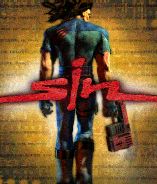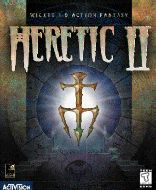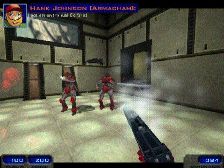|
|
|||||||||||||||
|
|
|
||||||||||||||
|
|
|
|
|
|
|
|
|
|
|
|
|
|
|
|
|
|
|
|
|
|
Hyperion: Ready For The New Amiga |
|
|
|
|
|||||||
|
|
|
|
|
|
|
|
|
||||||||
|
|
|
|
|
|
|
|
|
|
|
|
|
|
|
|
|
|
|
|
|
|
|
|||||||||||
|
|
|
|
|
|
|
|
|
|
|
|
|
|
|
|
|
|
|
|
|
|
|
|
|
Upstart European games house Hyperion is throwing its
resources behind the new Amiga, promising to port a whole range of top-class
PC hits. The firm will play a vital role in creating new Amiga compatibility
with OpenGL, the industry standard for displaying fast and smooth 3D graphic
sequences. |
|
|
||||||
|
|
|
|
|
|
|
|
|||||||||
|
|
|
|
|
|
|
|
|
|
|||||||
|
|
|
|
|
|
|
|
|
|
|
|
|
|
|
|
|
|
|
|
|
Hyperion's boss Ben Hermans is a Belgian lawyer and Amiga
enthusiast who has proved in the space of one year that it is possible to
license top-grade PC titles for the Amiga. For years, Amiga games players
waited in vain for major PC ports, but in most cases they never came (Quake
and Myth by Clickboom were notable exceptions). PC game publishers seemed not
really interested in the waning Amiga market, and too stringent in their
licensing conditions. Herman's experience in negotiating helped his young
company to succeed where others failed, porting major PC titles not only to
Amiga but also to Linux and Mac. The first product, Heretic II, will be
released shortly, and has already earned itself an Amiga Format Gold Medal
and AmigActive's Editor's Choice Award. Others are Sin, The Heretic Fortress,
Freespace: The Great War, Worms Armageddon, and Shogo. "We are going to
take as many as possible of the current high-end PC games that we have
licenses for and port them to run natively on the new Amiga," says Ben. "We are not looking at developing brand new games at
the moment. That would take two to three years, and the budgets are
atrocious. Games development in that respect is moving in the same direction
as movie production! We will continue to license high-end products on the PC
platform and get them over as fast as possible to the new Amiga
machines." |
|
|||||||||||
|
|
|
|
|
|
|
|
|
|
|
|
|
|
|
|
|
|
|
|
|
Amiga Inc. just recently sent two Hyperion developers to
a three day training course with Tao, one of Amiga's strategic partners
providing the foundation software for the Amiga environment. Upon their
return, these programmers started work on a native implementation of OpenGL.
Initially, Hyperion's work will be based on MESA, an OpenGL-compatible,
open-source 3D system developed on Unix/Linux machines. Obtaining the OpenGL license has traditionally been a
difficult task strewn with pitfalls, partly because of a host of tests, high
licensing fees, and a certain wariness on the part of the owners, SGI.
However, the situation is improving, according to Hermans. "Silicon Graphics has become a lot more lenient
since the Linux days. They are apparently working with NVidia to get an
official SGI OpenGL on the Linux platform, and becoming more favorable
towards open source and open standards in general." If Amiga ever does
decide to pursue an OpenGL license from SGI, Hyperion will be ready. "If
you're doing MESA you're 99% there," he says. All ports by Hyperion are first developed on the Amiga by
a team of three people, reworking code so that it is no longer dependent on
Windows and Intel x86 functions--replacing, for example, Microsoft Direct3D
with OpenGL. "It's a lot of work, but nothing can be done about
that", says Ben. "We don't have Direct3D, and we don't want
it!" Technically, the process of first preparing an Amiga port, and then
versions for Mac and Linux, has proved viable. Once the Amiga version is
finalized only another month of work is necessary to produce the Mac version.
|
|
|
|
|
|
|
|
|||||
|
|
|
|
|
|
|
|
|||||||||
|
|
|
|
|
|
|
|
|
|
|
||||||
|
|
|
|
|
|
|
|
|||||||||
|
|
|
|
|
|
|
|
|
|
|
||||||
|
|
|
|
|
|
|
|
|
|
|
|
|
|
|
|
|
|
|
|
|
|
|
|
|
|
So what does Hermans think of the possibilities that will
be opened up by the new Amiga? "Almost endless. The problem is that right now we're
being held back by outdated hardware. Even the current [Amiga] PPC boards are
three years old, with bottlenecks all over the place. We could start out with
a PPC Boxer or PoP motherboards." PoP is a public domain motherboard
design based on the former Common Hardware Reference Platform (CHRP) of IBM,
Apple and Motorola. "Looking at the Motorola roadmap it's clear that the
G4- G5 generations are going to be light-years ahead of anything that even
AMD will be able to offer. "Combine that with industry-leading graphics
capabilities, such as from NVidia, and you have an extremely capable
platform. The whole issue of the new Amiga's virtual processor makes almost
irrelevant what kind of hardware you are using," says Hermans. "The
good thing is that if I compile something for the new Amiga running on PoP
motherboards, it will run on x86 or whatever platform Amiga chooses to
support. All the code is being compiled to a virtual processor, which doesn't
exist, and the result is a completely platform-independent technology. |
|
|
|||||
|
|
|
|
|
|
|
|
|||||||||
|
|
|
|
|
|
|
|
|
|
|
||||||
|
|
|
|
|
|
|
|
|||||||||
|
|
|
|
|
|
|
|
|
|
|
||||||
|
|
|
|
|
|
|
|
|
|
|
|
|
|
|
|
|
|
|
|
|
This is very nice, because if something goes horribly
wrong with, say, IBM, and they decide to cancel PPC development, you're not
stuck to a specific object-code or whatever. You can say well, OK, let's use
something else! That along with the inherently high Java execution speed are
major advantages." Thanks in part to contract work with Monolith Inc.,
Hyperion has built up considerable expertise in one of today's most advanced
(if not the most advanced) 3D engine, LithTech. This is currently
going into overdrive, being licensed to Fox Interactive, 3DO, Interplay, and
others. "We are porting that engine to current and new Amiga
systems, and this will allow anything based on that engine to be ported by us
in a very short time, maybe two weeks", affirms Hermans. "We've
also ported Heretic II, which means that we have a very good understanding of
the Quake II engine, and this means that we can license games using this
engine and get them ported in a matter of weeks instead of months." "Our good relations with games publishers would
enable us to get a license before a game hits the market and a week or two
after the PC launch we can have it on the new platform as well," says
Hermans. "That's why we're focusing on specific engines, because if you
have that know-how you can move really quickly. We shall be demonstrating
that in the second quarter of this year, when we'll get a few Monolith titles
and make sure that they are released [on the Amiga, Mac and Linux] nearly
simultaneously with the PC version." Hermans is talking about ports to
the classic Amiga here, but he points out that there is no reason the same
procedure cannot be used for the new Amigas as soon as they become available.
Hyperion's proactive approach to preparing for the new
Amiga is what Amiga is looking for in a partner. This type of commitment to
the future will pay off for companies that recognize the possibilities of the
new Amiga. Hyperion surely envisions a bright future with the new Amiga. |
|
|||||||||||
|
|
|
|
|
|
|
|
|
|
|
|
|
|
|
|
|
|
|
|
|
|
|
|
|
|
|
|
|
|
|
|||
|
|
|
|
|
|
|
|
|
|
|
|
|
|
|
|
|





